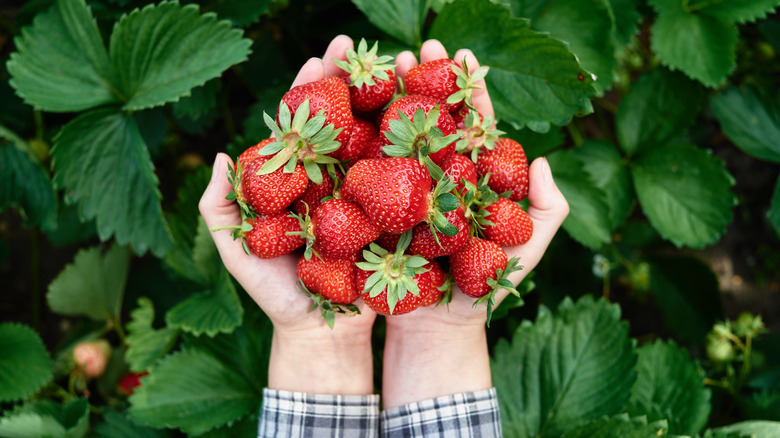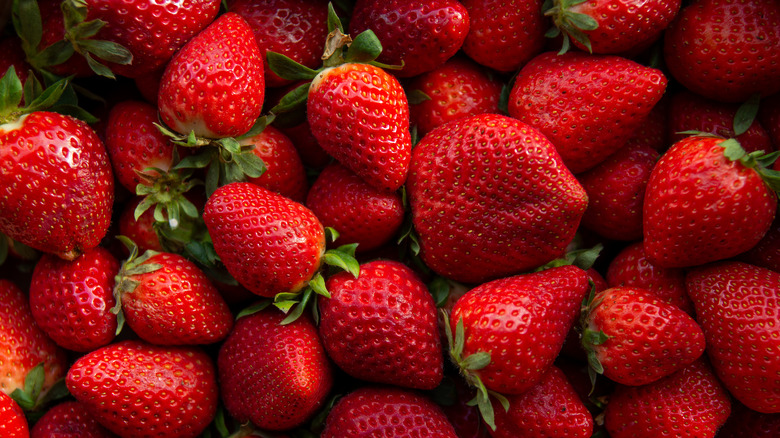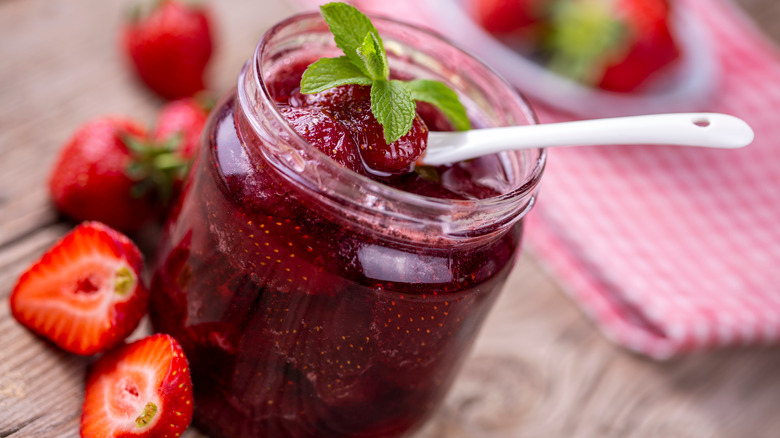The Best Method For Harvesting Your Garden's Strawberries
The United States is the largest producer of strawberries. While these grow in countless farms across the country, they are also perfect for your backyard garden due to their resilience to different climates and ability to thrive in various soil types. While strawberries are fascinating fruits, being part of the rose family and the only fruit with outside seeds, their undeniably luscious and sweet taste is what really draws us in. Many think the most important considerations behind amazing strawberries occur during the growing stage, and although that is undoubtedly important, it's also essential that they are harvested correctly.
When your berries ripen in late summer after a season of full sunshine and pollinating bees, you'll eagerly rush to pluck them from their vines. But strawberries must be harvested with a delicate hand to avoid harming the fruit or plant. So, whether you are gathering June-bearing, ever-bearing, or day-neutral strawberries, the harvesting process will remain the same, resulting in the perfect summer day snack and potluck recipes.
Safely harvesting ripe strawberries
The first step to harvesting strawberries is knowing when the fruit is ready to be plucked. Search for berries that boast entirely red skin and moderate firmness. Strawberries that are too light in color or too hard won't be ripe enough, and those that are too dark or squishy have surpassed the prime picking stage. Like most plants, strawberries and their vines are fragile and should be handled carefully, so never grab a berry and yank it off the vine. This not only bruises the fruit but also harms the plant's foliage and roots.
To avoid pulling, use a clean and sharp pair of shears to cut the stem of the strawberry off the plant. If you don't have a pair of garden scissors, you can use your hands by tightly pinching directly above the fruit and giving a twist to snap it off. As you collect your strawberries, use a spacious container to place them in gently. Metal sheet pans, elongated baskets, and oval plastic tubs are great for collecting strawberries. Dropping the berries on top of one another or stacking them too high in a small space can damage the fruit. Additionally, keeping your freshly picked crop shaded during harvesting will help increase its lifespan. Once ripe berries have started appearing, you should venture out to the vine once every two to three days to gather more as they reach full maturity.
Using your newly harvested strawberries
After bringing in your fresh strawberries, refrain from washing any that you don't plan to use immediately. Waiting to wash the fruit until you are ready to eat will help maintain its beloved texture. Typically, garden-fresh strawberries will last 2 to 3 days in the fridge and up to 2 months in the freezer. You can use tips and tricks, like a vinegar wash or lining the container with paper towels, to increase their life span in the fridge.
Eating your strawberries is one of the most rewarding parts of the process, and you'll be happy to know they have fantastic health benefits. Strawberries are high in many nutrients, like vitamin C, vitamin K, calcium, magnesium, and potassium. They also harbor antioxidants that prevent health issues such as cancer, heart disease, and diabetes. So you can't go wrong using this fruit in your pancakes, salads, smoothies, and jams.


